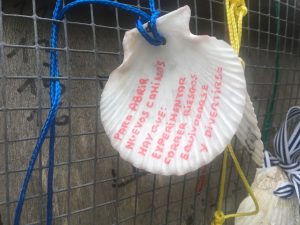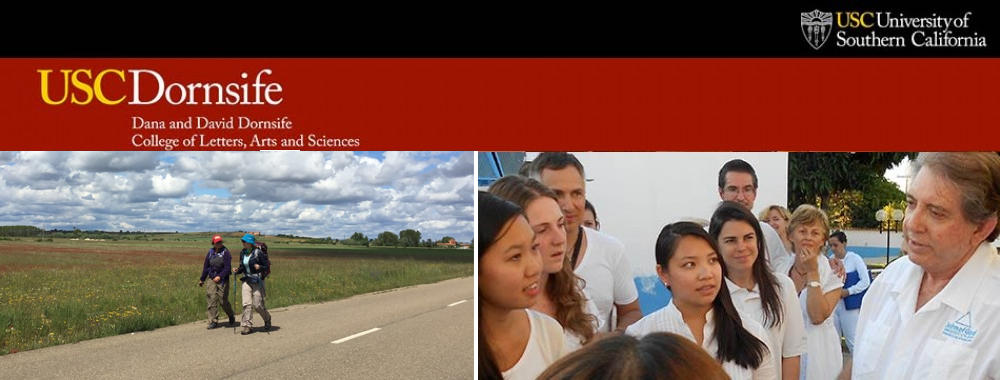All along the Camino, on sidewalks and overpasses, statues and rocks, people scrawl messages, drawings, and words of wisdom. Many encapsulate the experience of the Camino and the lessons people learn. I’ve chosen five that tell the story of my Camino.

La Vida es Peregrina, above a ubiquitous image of this dog.
“La vida es peregrina.” (Life is a pilgrimage), Rubiães, Portugal
Leaving the Camino does not mean that it is over. As our Dutch friend Constance says, “You take the Camino with you.” She divides her life into before her first Camino and after the Camino, because of the transformative effect it had on her worldview. All of life becomes a pilgrimage when tackled with the attitude and strength of a pilgrim. You learn to embrace the positive and negative alike, from snoring Italians in albergues to beautiful sunsets at the end of the world.
 “Os nosos montañeiros, Jesus e Toni Martinez Novas, polo seu espirito de esforzo e sacrificio en defensa de paz e o medio ambiente.”(For our mountaineers, Jesus and Toni Martinez Novas, for their strong spirit and sacrifice in defense of peace and the environment.), O Porriño, Spain
“Os nosos montañeiros, Jesus e Toni Martinez Novas, polo seu espirito de esforzo e sacrificio en defensa de paz e o medio ambiente.”(For our mountaineers, Jesus and Toni Martinez Novas, for their strong spirit and sacrifice in defense of peace and the environment.), O Porriño, Spain
This tribute to two Galician mountain climbers speaks to the kind of people found on the Camino. A great many of the pilgrims I’ve met are there primarily because of their love of hiking and the outdoors. The Camino draws adventurers who have done other long-distance hikes such as the Appalachian Trail, Pacific Crest Trail, Inca Trail, and Mt. Kilimanjaro.
“Pensar diferente no es un delito, es un derecho y a veces un privilegio.” Thinking differently isn’t a crime, it is a right and sometimes a privilege. Arcade, Spain
For me, an important thing to remember along the Camino is that the ability to adopt this different way of living is absolutely a privilege. It is accessible primarily to those who can afford to travel and walk. The pilgrims I’ve met on average have been financially stable, older, and whiter. While to some the Camino is “not a vacation at all,” but about reflection and suffering, it still requires a certain amount of stability, not to mention the time, money, and gear needed for the Camino. We must remind ourselves how lucky we are to be here.
“O único camiño que se fai siguiendo as Estrellas” (The only Camino that follows the stars.) Pontevedra, Spain
 This Estrella Galicia beer ad takes a jab at the French route, often called the “Camino de las estrellas” because it follows the milky way. The strong Galician identity was evident from the moment we crossed over from Portugal and into Santiago–in food, language, graffiti, and, of course, beer. The billboard is also a great example of the commercial potential many companies find in the Camino’s pilgrims. Stores, restaurants, and albergue owners often rely on the influx of pilgrims in the summer months to support themselves throughout the rest of the year. The Camino, for all its spirituality and personal importance, is certainly not untouched by economic interests.
This Estrella Galicia beer ad takes a jab at the French route, often called the “Camino de las estrellas” because it follows the milky way. The strong Galician identity was evident from the moment we crossed over from Portugal and into Santiago–in food, language, graffiti, and, of course, beer. The billboard is also a great example of the commercial potential many companies find in the Camino’s pilgrims. Stores, restaurants, and albergue owners often rely on the influx of pilgrims in the summer months to support themselves throughout the rest of the year. The Camino, for all its spirituality and personal importance, is certainly not untouched by economic interests.
 “Para abrir nuevos caminos hay que: experimentar, correr riesgos, equivocarse y divertirse.” (To open up new pathways you must: experiment, take risks, make mistakes, and have fun). Arcade, Spain
“Para abrir nuevos caminos hay que: experimentar, correr riesgos, equivocarse y divertirse.” (To open up new pathways you must: experiment, take risks, make mistakes, and have fun). Arcade, Spain
The Camino is an incredibly reflective space, and many who come to walk are at a crossroads in life, unsure of the way forward. The time to take risks, make mistakes, and enjoy time away from the stress of life back home creates a unique atmosphere of acceptance and reflection.
